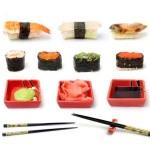
Ocean breezes, island life, and a temperate climate have each contributed to Japan’s cuisine, but how has history affected the archipelago’s many fine dishes?
The Japanese affinity for natural and seasonal cooking began long before 300 B.C. during the Jomon Era. Hunter-gatherers collected tender bamboo shoots and chestnuts in season and harvested the ocean’s bounties. Short-grain rice arrived directly, and soon the Japanese were enjoying sake and rice vinegar with their uni. In time, they developed a culinary philosophy that promoted seasonal foods with fresh, naturally-imbued flavors derived from bonito, konbu, and shiitake.
Buddhism, introduced in A.D. 538 during the Asuka period, had a profound influence on Japanese vegetarianism. In 675, Emperor Temmu prohibited the eating of mammals and poultry, and a Buddhist monk served Emperor Saga his first Chinese tea in 815 (Heian Period). In 1237, a Zen Buddhist named Dogen, inspired by living in China, wrote a cookbook called “Instructions for the Cook”, in which he advocated simple and nourishing cooking as a metaphor for life. His cooking style, using rustic or wild ingredients, is perpetuated in Japan today.
After the Mongol invasion of 1274, cross-cultural food exchanges with China diminished until the advent of the Ming Dynasty in 1368. In a resurgence of Chinese influence, noodles gained popularity. Then, during the 15th century, a new fermentation process popularized sushi. In 1543 (Sengoku Period), the arrival of a Portuguese ship helped disseminate European-style foods, including tempura and oils. Meanwhile, Sen no Rikyu formalized the Japanese tea ceremony and promoted culinary simplicity.
The Tokugawa Period (1603-1868) provided a long interval of prosperity and innovation, including a renaissance in cooking. Rich merchants and artisans controlled the economy, setting the tone for food fashion and creating a demand for restaurants adept at presentation. Portuguese contributions continued in the form of deep-fried tofu (aburaage). The Japanese developed ganmodoki (fritters) made with konnyaku, a plant-derived gelatin. New technologies caused an upsurge in the availability of soy sauce and soba noodles with the result that sashimi consumption increased. However, hand-rolled sushi did not appear until the late 18th century.
Conclusively, the Tokugawa’s isolationism from 1639 to 1854 froze Japanese food culture in time. The absence of outside influences during this 15-year period may be one reason traditional Japanese recipes still exist today. People should keep history in mind next time they enjoy a delectable kinpira of lotus root and arame.
